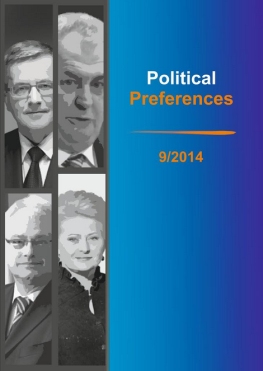Bhatti Y., Hansen K. M. (2014), Turnout at European Parliament elections is likely to continue to decline in the coming decades, London School of Economics European Politics and Policy blog, http://blogs.lse.ac.uk/europpblog/2013/07/25/turnout-at-european-parliamentelections-is-likely-to-continue-to-decline-in-the-coming-decades/, (16.09.2014).
Google Scholar
Cześnik M. (2006), Voter Turnout and Democratic Legitimacy in Central Eastern Europe, „Polish Sociological Review”, vol. 156: 449-470.
Google Scholar
Cześnik M. (2007), Partycypacja wyborcza w Polsce. Perspektywa porównawcza, Warszawa: Scholar.
Google Scholar
Cześnik M. (2008), Polish ‘Exceptionalism’: Voter Turnout in Poland in light of CSES data, paper presented at the CSES Conference and Planning Committee Meeting, Warsaw, April 2008.
Google Scholar
Cześnik M. (2009), Voter Turnout Stability – Evidence from Poland, „Polish Sociological Review”, vol. 165: 107-122.
Google Scholar
Cześnik M. (2011), Uczestnictwo wyborcze a struktura społeczna w świetle badań PGSW. Czym różnią się głosujący od niegłosujących, „Studia Polityczne”, nr 28: 7-28.
Google Scholar
Cześnik M., Zerkowska-Balas M., Kotnarowski M. (2013), Voting as a habit in New Democracies – Evidence from Poland, „Communist and Post-Communist Studies”, vol. 46: 95-107.
Google Scholar
Follesdal A., Hix S. (2006), Why There is a Democratic Deficit in the EU: A Response to Majone and Moravcsik, „Journal of Common Market Studies”, vol. 44(3): 533–562.
Google Scholar
Grönlund K., Setälä M. (2007), Political Trust, Satisfaction and Voter Turnout, „Comparative European Politics”, vol. 5: 400–422.
Google Scholar
How much legislation comes from Europe?, House of Commons Library, Research Paper 10/62, 13.10.2010.
Google Scholar
Jasiewicz K. (2008), The New Populism in Poland: The Usual Suspects?, „Problems of Post-Communism”, vol. 55: 7-25.
Google Scholar
Markowski R. (2006), The Polish Elections of 2005: Pure Chaos or Restructuring of the Party System?, „West European Politics”, vol. 29: 814-832.
Google Scholar
Markowski R. (2008), The 2007 Polish Parliamentary Election: Some Structuring, Still a Lot of Chaos, „West European Politics”, vol. 31: 1055-1068.
Google Scholar
Markowski R., Cześnik M. (2002), Polski system partyjny: dekada zmian instytucjonalnych i ich konsekwencje, [in:] R. Markowski (ed.), System partyjny i zachowania wyborcze. Dekada polskich doświadczeń, Warsaw: ISP PAN and Friedrich Ebert Stiftung.
Google Scholar
Marsh M., Mikhaylov S., European Parliament elections and EU governance, Living Reviews in European Governance, http://europeangovernance.livingreviews.org/ (16.09.2014).
Google Scholar
McDougall O., Mody A. (2014), Will voters turn out in the 2014 European Parliamentary elections?, VOX, http://www.voxeu.org/17.05.2014 (16.09.2014).
Google Scholar
Millard F. (2009), Poland: Parties without a Party System, „Politics and Policy”, vol. 37(4): 781-798.
Google Scholar
Moravcsik A. (2008), The Myth of Europe’s “Democratic Deficit”, „Intereconomics”, November/December 2008.
Google Scholar
Reif K., Schmitt H. (1980), Nine Second Order National Elections: A Conceptual. Framework for the Analysis of European Election Results, „European Journal of Political Research”, vol. 8(1): 3–44.
Google Scholar
Ulrich J. M., Harris A. L. (2003), GenXegesis: Essays on Alternative Youth (Sub)Culture, Madison: Popular Press.
Google Scholar



 10.31261/polpre
10.31261/polpre